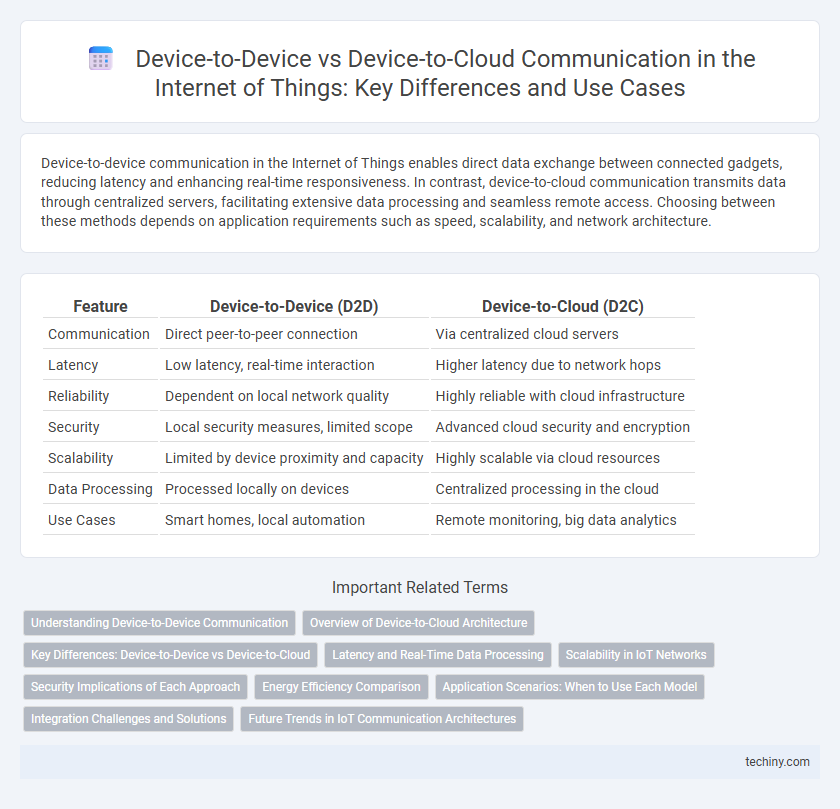Device-to-device communication in the Internet of Things enables direct data exchange between connected gadgets, reducing latency and enhancing real-time responsiveness. In contrast, device-to-cloud communication transmits data through centralized servers, facilitating extensive data processing and seamless remote access. Choosing between these methods depends on application requirements such as speed, scalability, and network architecture.
Table of Comparison
| Feature | Device-to-Device (D2D) | Device-to-Cloud (D2C) |
|---|---|---|
| Communication | Direct peer-to-peer connection | Via centralized cloud servers |
| Latency | Low latency, real-time interaction | Higher latency due to network hops |
| Reliability | Dependent on local network quality | Highly reliable with cloud infrastructure |
| Security | Local security measures, limited scope | Advanced cloud security and encryption |
| Scalability | Limited by device proximity and capacity | Highly scalable via cloud resources |
| Data Processing | Processed locally on devices | Centralized processing in the cloud |
| Use Cases | Smart homes, local automation | Remote monitoring, big data analytics |
Understanding Device-to-Device Communication
Device-to-device communication in the Internet of Things enables direct data exchange between connected devices without relying on cloud infrastructure, enhancing real-time responsiveness and reducing latency. This approach improves network efficiency by minimizing cloud traffic and enabling localized processing and decision-making. Industrial IoT applications and smart home systems benefit from device-to-device protocols like Bluetooth Mesh and Zigbee to ensure seamless, low-power connectivity among devices.
Overview of Device-to-Cloud Architecture
Device-to-cloud architecture enables IoT devices to communicate directly with centralized cloud platforms, allowing for scalable data storage, advanced analytics, and remote management. This model supports seamless integration with cloud services, facilitating real-time data processing and broader accessibility across distributed networks. Contrasted with device-to-device communication, device-to-cloud architecture enhances security and reliability by leveraging cloud infrastructure for authentication, encryption, and consistent device updates.
Key Differences: Device-to-Device vs Device-to-Cloud
Device-to-Device (D2D) communication in IoT enables direct interaction between devices, reducing latency and dependency on centralized servers, which enhances real-time response capabilities. In contrast, Device-to-Cloud (D2C) communication involves sending data to centralized cloud platforms for processing, storage, and analytics, offering scalability and extensive computational resources. Key differences include latency, with D2D providing faster exchanges, and data management, where D2C supports complex data analysis and long-term storage.
Latency and Real-Time Data Processing
Device-to-device communication in Internet of Things (IoT) systems significantly reduces latency by enabling direct data exchange between devices without routing through cloud servers, supporting real-time data processing essential for time-sensitive applications like autonomous vehicles and industrial automation. Device-to-cloud communication often experiences higher latency due to data transmission over the internet to centralized servers, which can introduce delays unsuitable for critical real-time operations. The choice between device-to-device and device-to-cloud architectures depends on the specific IoT application requirements, where low latency and immediate response favor device-to-device connectivity, while cloud-based models benefit from extensive data storage and complex analytics.
Scalability in IoT Networks
Device-to-device (D2D) communication in IoT networks enhances scalability by enabling direct data exchange between devices, reducing reliance on central cloud servers and minimizing latency. In contrast, device-to-cloud models depend on cloud infrastructure for data processing and storage, which can introduce bottlenecks as the number of connected devices increases exponentially. Leveraging D2D communication improves network efficiency and supports large-scale deployments by distributing processing loads across devices, thereby optimizing IoT scalability.
Security Implications of Each Approach
Device-to-device (D2D) communication minimizes exposure to cloud vulnerabilities by enabling direct data exchange, reducing the risk of interception or unauthorized access during transmission. Device-to-cloud (D2C) interactions centralize data processing and storage, increasing potential attack surfaces but allowing for enhanced security protocols through cloud-based encryption and continuous monitoring. Understanding the security implications of each method is critical for designing IoT systems that balance performance, privacy, and protection against cyber threats.
Energy Efficiency Comparison
Device-to-device communication in the Internet of Things significantly reduces energy consumption by enabling direct data exchange without routing through the cloud, minimizing latency and power usage in wireless transmissions. In contrast, device-to-cloud architectures often require continuous connectivity and higher transmission power to maintain reliable cloud access, leading to increased energy expenditure. Energy efficiency is further enhanced in device-to-device models through localized processing and reduced reliance on centralized servers, making it ideal for battery-operated IoT devices in remote or power-constrained environments.
Application Scenarios: When to Use Each Model
Device-to-device communication excels in time-sensitive applications like industrial automation and emergency response where low latency and real-time actions are critical. Device-to-cloud is ideal for large-scale data aggregation, remote monitoring, and analytics in smart cities or IoT-enabled healthcare systems. Selecting between these models depends on factors such as latency requirements, network availability, and data processing complexity.
Integration Challenges and Solutions
Device-to-device (D2D) communication offers low latency and localized data exchange but faces challenges in seamless integration due to diverse protocols and security vulnerabilities. Device-to-cloud (D2C) models provide centralized management and scalability but struggle with network dependency and increased latency. Hybrid solutions leveraging edge computing and standardized communication protocols address these integration challenges by combining local processing with cloud analytics for optimal IoT performance.
Future Trends in IoT Communication Architectures
Device-to-device (D2D) communication in IoT is evolving towards ultra-low-latency and high-reliability applications, leveraging edge computing and 5G technologies to enable real-time data exchange without cloud dependency. Device-to-cloud (D2C) architectures continue to advance by integrating AI-driven analytics and scalable cloud platforms, enhancing centralized data processing and long-term storage capabilities. Emerging hybrid models combine D2D and D2C benefits, optimizing network efficiency and enabling seamless transitions between local and cloud processing to accommodate diverse IoT use cases.
Device-to-device vs Device-to-cloud Infographic

 techiny.com
techiny.com